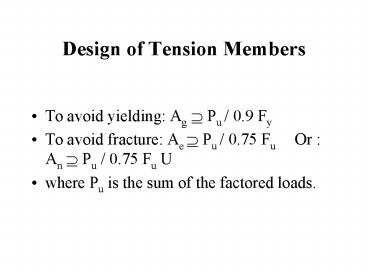Design of Tension Members PowerPoint PPT Presentation
Title: Design of Tension Members
1
Design of Tension Members
- To avoid yielding Ag ? Pu / 0.9 Fy
- To avoid fracture Ae ? Pu / 0.75 Fu Or
An ? Pu / 0.75 Fu U - where Pu is the sum of the factored loads.
2
Design of Tension Members
- If the axial load in a slender tension member is
removed and small transverse loads are applied,
undesirable vibrations or deflections may occur.
Thus AISC recommends - r ? L/300 ( not for cables or rods)
- where r is the minimum radius of gyration of the
cross section and L is the length of the member.
3
Threaded Rods and Cables
- When slenderness is not a consideration, circular
rods and cables are often used (hangers,
suspended bridges). - Rods are solid and cables are made from
individual strands wound together. - Threading the end of a rod reduces the cross
sectional area (upset end prevents such
reduction, but is expensive).
4
(No Transcript)
5
Threaded Rods and Cables
- ?t Pn 0.75 (0.75 Ab Fu)
- Ab nominal (unthreaded) area
- It is common to use a min diameter of 5/8 in. for
rods.
6
Threaded Rods and Cables
- A strand consists of individual wires wound
helically around a centrl core. - A wire rope is made of several strands laid
helically around a core.
7
Tension Members in Roof Truss
- Trusses are used where the cost and weight of a
beam could be prohibitive (long spans). - A truss may be thought of as a deep beam with
much of the web removed. - Tension members in roof trusses include some
truss members and sag rods.
8
Sag Rods
- Sag rods are used to provide lateral support for
the purlins (to prevent sag in direction parallel
to a sloping roof due to vertical applied loads). - They are designed to support the component of
roof loads parallel to the roof.
9
(No Transcript)
10
(No Transcript)
11
Sag Rods
- Each segment between purlins is assumed to
support everything below it thus the top rod is
designed for the load on the roof area tributary
to the rod, from the heel of the truss to the
peak.
12
(No Transcript)
13
Sag Rods
- The tie rod between ridge purlins must resist the
load from all of the sag rods on either side.
PowerShow.com is a leading presentation sharing website. It has millions of presentations already uploaded and available with 1,000s more being uploaded by its users every day. Whatever your area of interest, here you’ll be able to find and view presentations you’ll love and possibly download. And, best of all, it is completely free and easy to use.
You might even have a presentation you’d like to share with others. If so, just upload it to PowerShow.com. We’ll convert it to an HTML5 slideshow that includes all the media types you’ve already added: audio, video, music, pictures, animations and transition effects. Then you can share it with your target audience as well as PowerShow.com’s millions of monthly visitors. And, again, it’s all free.
About the Developers
PowerShow.com is brought to you by CrystalGraphics, the award-winning developer and market-leading publisher of rich-media enhancement products for presentations. Our product offerings include millions of PowerPoint templates, diagrams, animated 3D characters and more.

